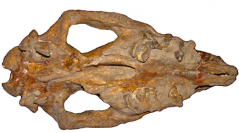

 Comptes Rendus Palevol
11 (8) - Pages 555-562
Comptes Rendus Palevol
11 (8) - Pages 555-562In China, the non- Coelodonta dicerorhines are too diverse to be placed entirely in the genus Dicerorhinus. Most of the Pleistocene species should be transferred to the European genus Stephanorhinus because they differ from the Dicerorhinus species. Those differences include a much larger body size, a dolicocephalic skull, the absence of incisors, a partially ossified nasal septum, a closed subaural channel, a more anteriorly positioned infraorbital foramen, and a robust postglenoid process combined with a less developed paroccipital process. However, the cranium once referred to Rhinoceros sinensis from the Yunxian Man Site should be transferred to Dicerorhinus because of the presence of smaller incisors, an open subaural channel, a high and nearly vertical occipital face, and the more anterior position of the anterior root of the zygomatic arch. In China, the interspecific differences among the Stephanorhinus species are more striking than among those of Europe. The evolution of the non- Coelodonta dicerorhines in China was punctuated around the Plio/Pleistocene transition, and it seems difficult to link the diverse Pleistocene dicerorhines with the indigenous Neogene ones. The generic attributions of the Neogene dicerorhines require further study.
Dicerorhines, Dicerorhinus, Stephanorhinus, Evolution, China